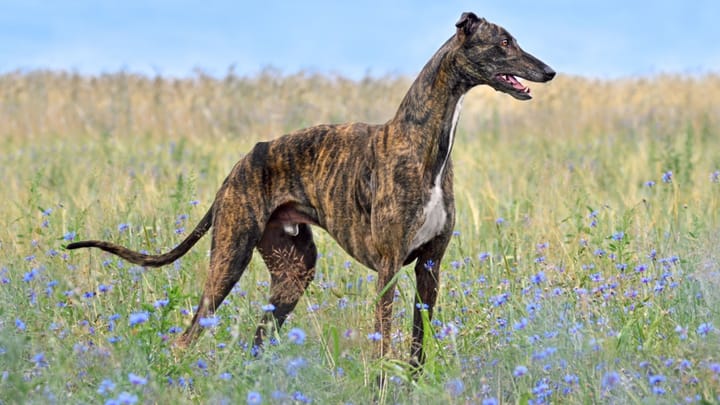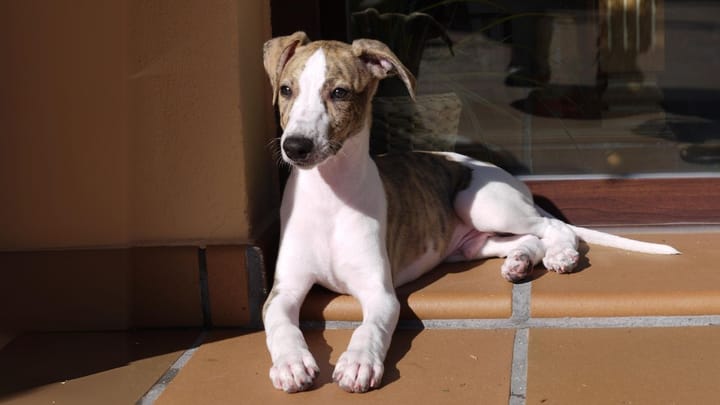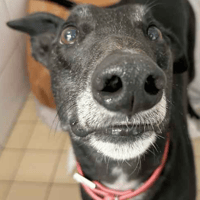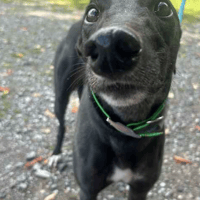Greyhound
Other name: English Greyhound


First bred as a hunting companion and a racing dog, the Greyhound has become a popular family pet. Although capable of a top speed of up to 40mph, the greyhound is a placid and gentle breed that prefers to spend most of its time relaxing. Greyhounds are most happy in quiet, relaxed environments. These gentle animals make excellent pets for families with small children and other dogs.
|
Life expectancy |
The Greyhound has a life expectancy of between 9 and 11 years |
|
Temperament |
|
|
Size |
Large
|
|
Adult size |
Female
Between 27 and 28 in
Male
Between 28 and 30 in
|
|
Adult weight |
Female
Between 62 and 73 lb
Male
Between 62 and 73 lb
|
|
Coat colour
A greyhound’s coat can be one of any 30 recognised colours, including white, brown, black, fawn, grey, and blue/grey. |
Black White Blue Red |
|
Type of coat
Very short. Short and smooth with some shedding. |
Short |
|
Eye colour
Eye colour varies, although it’s likely to be dark brown or a darker green. |
Brown
|
|
Purchase price |
The Greyhound costs between £280 and £600 |
Because of a greyhounds sensitivity to pesticides, speak to your vet before using any flea collars or sprays. The same goes for any ticks treatments.
The Greyhounds long, lean physique isn't suited to hard surfaces; make sure they have a nice, comfy bed made from soft material.
Greyhounds have unique blood chemistry. They have a high amount of red blood cells, and their livers have lower levels of certain enzymes. If your Greyhound has any blood tests, make sure your vet is aware of your dog's unusual blood chemistry as it can to misdiagnosis.
More details about the Greyhound
Greyhound: Origins and history
Although there is no scientific evidence, there are suggestions that greyhound-like dogs existed as long as 4,000 years ago. Reference to these animals appear in ancient Egyptian culture, and they may have been used as hunting dogs by Celtic tribes from 5th and 6th century BC. The first reports of the modern greyhound appear in the 18th century. It was then officially recognised by British kennel authorities in the 19th century. Since then, the Greyhound has had a long and illustrious career as a hunting companion and racing dog.
Physical characteristics of the Greyhound
Greyhounds have lean, muscular frames with a deep chest, powerful legs, and a flexible spine. Greyhounds are dolichocephalic, which means they have a long, narrow skull and an elongated muzzle.
FCI classification of the Greyhound
-
Group 10 - Sighthounds
-
Section 3 : Short-haired Sighthounds
Greyhound: Characteristics
Greyhound: Behaviour
Training a Greyhound
Greyhounds respond best to gentle, reward-based training methods. As long as you stick to these techniques, it won't be long before you have a very well-trained and very obedient greyhound. You’ll also need a little bit of patience as greyhound puppies tend to be extremely boisterous, meaning they can struggle to focus on a specific task. So keep the training sessions short and fun.
Greyhound: Lifestyle
Breed compatibility Greyhound
Greyhound: Purchase price
A Greyhound pup can cost anywhere between £280 - £600, and there are many ex-racing and rescue greyhounds looking for a new home!
Greyhounds don't need massive amounts of food; two medium-sized meals made from high-quality dog food will meet all their nutritional needs. Budget between £40-60 each month to cover the cost of feeding your greyhound. Other expenses, like insurance, will vary depending on your dog's age and medical history.
Greyhound: Shedding
None
Greyhounds are not prone to suffering from any medical conditions that can lead to hair loss. However, given their short coats, any instances of hair loss may look worse than they actually are.
Greyhound: Grooming
Greyhounds have short coats which are really easy to maintain. They also shed very little, saving you the time and money involved with regular trips to the doggy salon. A quick weekly brush is all a greyhound really needs.
Greyhound: Health
The average lifespan for a greyhound is between 9-11 years.
The Greyhound is robust but as it doesn't like cold temperatures he must always be protected when the weather is bad. You also have to pay attention to the accidents that can occur while running: the dog can be injured easily and must be treated in time to avoid any infection.
The heat can quickly be harmful for this dog: its activities (including coursing) must be arranged during periods of heat wave.
A winter coat is an essential accessory for any Greyhound. Because of their short coats and lean frames, greyhounds can struggle to maintain healthy body temperature in cold weather. This means they'll always need their coats on during winter and it's best to avoid walking them during the coldest parts of the day, such as early morning or late evening.
Greyhounds do have a greedy side. However, their naturally lean frames and taste for high-intensity exercise means you never really see an obese greyhound. Still, don’t overfeed them and always keep doggy treats within strict limits.
- Oesophagal achalasia
- Gastric dilation volvulus (bloat)
- Osteosarcoma
- Alabama Rot
- Sensitivity to pesticides

















